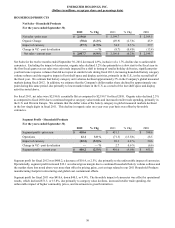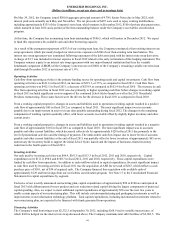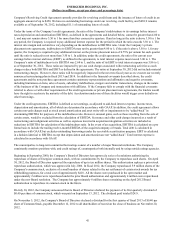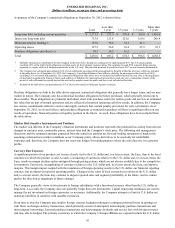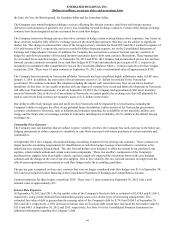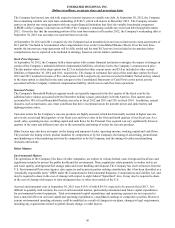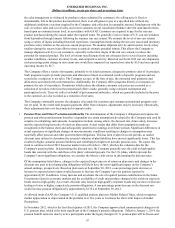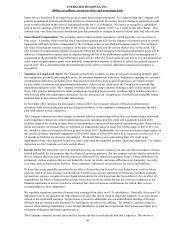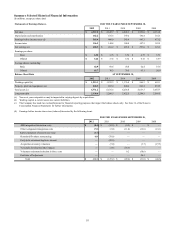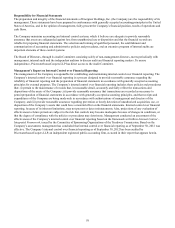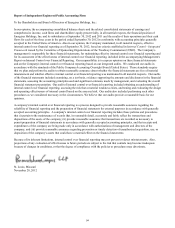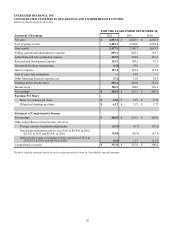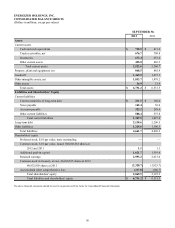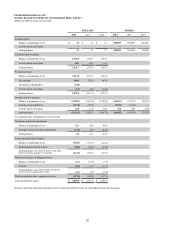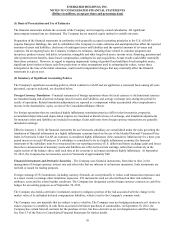Energizer 2012 Annual Report Download - page 59
Download and view the complete annual report
Please find page 59 of the 2012 Energizer annual report below. You can navigate through the pages in the report by either clicking on the pages listed below, or by using the keyword search tool below to find specific information within the annual report.
ENERGIZER HOLDINGS, INC.
(Dollars in millions, except per share and percentage data)
estimating taxable earnings, specific taxable and deductible items, the likelihood of generating sufficient future taxable
income to utilize deferred tax assets, the portion of the income of foreign subsidiaries that is expected to be remitted to
the U.S. and be taxable and possible exposures related to future tax audits. Deferred tax assets are evaluated on a
subsidiary by subsidiary basis to ensure that the asset will be realized. Valuation allowances are established when the
realization is not deemed to be more likely than not. Future performance is monitored, and when objectively
measurable operating trends change, adjustments are made to the valuation allowances accordingly. To the extent the
estimates described above change, adjustments to income taxes are made in the period in which the estimate is
changed.
The Company operates in multiple jurisdictions with complex tax and regulatory environments, which are subject to
differing interpretations by the taxpayer and the taxing authorities. At times, we may take positions that management
believes are supportable, but are potentially subject to successful challenges by the appropriate taxing authority. The
Company evaluates its tax positions and establishes liabilities in accordance with guidance governing accounting for
uncertainty in income taxes. The Company reviews these tax uncertainties in light of the changing facts and
circumstances, such as the progress of tax audits, and adjusts them accordingly.
• Acquisitions, Goodwill and Intangible Assets The Company allocates the cost of an acquired business to the assets
acquired and liabilities assumed based on their estimated fair values at the date of acquisition. The excess value of the
cost of an acquired business over the estimated fair value of the assets acquired and liabilities assumed is recognized
as goodwill. The valuation of the acquired assets and liabilities will impact the determination of future operating
results. The Company uses a variety of information sources to determine the value of acquired assets and liabilities
including: third-party appraisers for the values and lives of property, identifiable intangibles and inventories; actuaries
for defined benefit retirement plans; and legal counsel or other experts to assess the obligations associated with legal,
environmental or other claims.
Significant judgment is required in estimating the fair value of intangible assets and in assigning their respective
useful lives. The fair value estimates are based on historical available information and on future expectations and
assumptions deemed reasonable by management, but are inherently uncertain. Determining the useful life of an
intangible asset also requires judgment. Certain brand intangibles are expected to have indefinite lives based on their
history and our plans to continue to support and build the acquired brands. Other intangible assets are expected to have
determinable useful lives. Our assessment of intangible assets that have an indefinite life and those that have a
determinable life is based on a number of factors including the competitive environment, market share, brand history,
underlying product life cycles, operating plans and the macroeconomic environment. Our estimates of the useful lives
of determinable-lived intangible assets are primarily based on the same factors. The costs of determinable-lived
intangible assets are amortized to expense over the estimated useful life. The value of indefinite-lived intangible assets
and residual goodwill is not amortized, but is tested at least annually for impairment.
However, future changes in the judgments, assumptions and estimates that are used in our impairment testing
including discount and tax rates or future cash flow projections, could result in significantly different estimates of the
fair values in the future. A reduction in the estimated fair values could result in impairment charges that could
materially affect our financial statements in any given year. The recorded value of goodwill and intangible assets from
recently acquired businesses are derived from more recent business operating plans and macroeconomic
environmental conditions and, therefore, are more susceptible to an adverse change that could require an impairment
charge.
During fiscal 2012, we tested goodwill for impairment for both the Energizer and Personal Care reporting units. There
were no indications of impairment of goodwill noted during this testing.
In addition, we completed impairment testing on indefinite-lived intangible assets other than goodwill, which are
trademarks/brand names used in our various product categories. No impairment was indicated as a result of this
testing. However, the recorded values for two brands, Playtex and Wet Ones, were relatively close to the carrying
value at approximately 115% of the carrying value (approximately $650) for the Playtex brand and approximately
106% of the carrying value (approximately $200) for the Wet Ones brand. Key assumptions included in the testing of
these brand values were a discount rate of 8.00% and a terminal growth rate of 2.75%.
49


